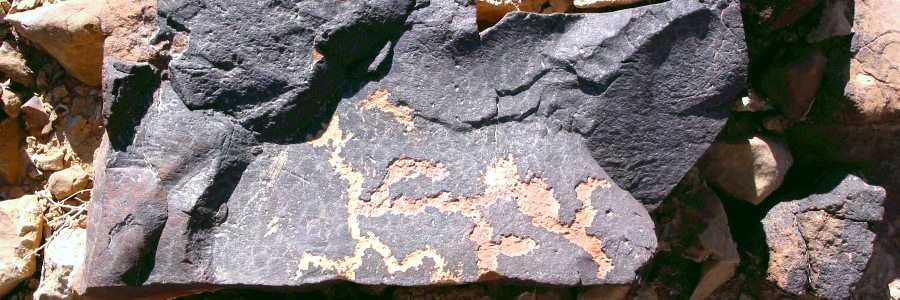
Ugaritic Baal Cycle, Canaanite Myth in Negev Rock Art
This rock art portrays the Canaanite Baal Cycle, a myth shaped by the rhythms of the alternating Mediterranean climate. At its heart, the myth presents a cosmic struggle between Baal, the storm god of rain and fertility, and Mot, the god of death and drought. (Smith 1994). Their perpetual conflict not only explained the turning of the seasons but also embodied the profound tension between life and death at the core of human existence.
The myth’s central conflict pits Baal against Mot, sons of the high god El. A key episode, recorded in Ugarit (KTU 1.6.VI:12–22), recounts: (Töyräänvuori 2012)
“Baal returns to reign over Earth, but Mot resists. A fierce battle ensues, and Baal seems doomed. Then El, stirred by a prophetic dream, declares Baal the rightful ruler. He sends Shapash, the sun goddess, to halt the fight and proclaim Baal’s kingship.”
Similar myths flourished throughout the ancient Near East. In Mesopotamia, Tammuz (Dumuzi) descends each year into the underworld, embodying the death and rebirth of vegetation. In Egypt, Osiris dies and returns, mirroring the Nile’s flooding and renewal. Like the Baal Cycle, these stories employ divine drama to express natural forces and seasonal change. (Pardee 2002; Wyatt 1998). Dated between 1200–600 BCE, this Negev rock art reflects how Ugaritic religious concepts spread and adapted across the southern Levant.
Baal and Mot myth in rock art
The Negev Desert rock art (Fig. 1) visually echoes this myth through a dramatic confrontation between the two, Baal and Mot, symbolic figures. Their symmetrical placement suggests cosmic balance, while their bird-like heads represent divine beings.

The figures clash in a balanced struggle, yet Baal emerges triumphant, standing tall with an upraised hand, while Mot falls, struck by Baal’s secret weapon—the thunderbolt, symbol of divine rain and fertility. Between them appears Shapash, marked in red, embodying the sun goddess who enforces cosmic law and restores harmony. Despite its stylistic simplicity, the rock art conveys motion, tension, and symbolic depth with remarkable clarity.
Conclusion
The Negev Desert rock art depicting the Ugaritic Baal Cycle represents a remarkable synthesis of mythological depth and artistic economy. The tale of Baal and Mot, sons of the supreme deity El, reflects the seasonal rhythm of drought and renewal in the Levant. Engraved into desert stone, the scene of their climactic battle preserves an ancient vision of cosmic balance and the triumph of life over death. (Smith 1994; Pardee 2002).
Related reading
Bibliography
Pardee, Dennis. Ritual and Cult at Ugarit.
Töyräänvuori, Johanna. Weapons of the Storm God in Ancient Near Eastern and Biblical Traditions.
Smith, Mark S. The Ugaritic Baal Cycle.
Wyatt, Nicolas. Religious Texts from Ugarit: The Words of Ilimilku and His Colleagues.
© All rights reserved. This material may not be published, broadcast, rewritten, or redistributed in whole or part without the express written permission of negevrockart.co.il
Yehuda Rotblum
